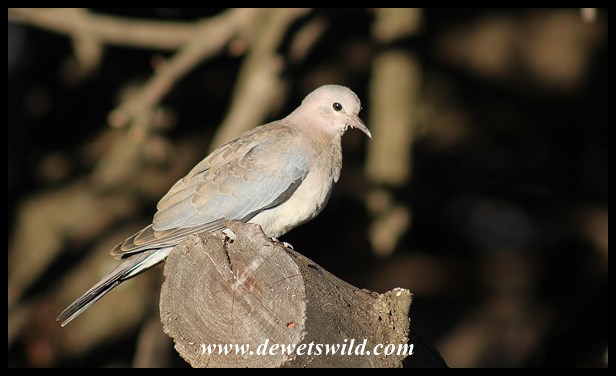Streptopelia senegalensis
Occurring over the entire country, most South Africans would be familiar with the Laughing Dove as a common garden bird (to the point of being considered a pest by many). They inhabit a wide range of habitats, avoiding only forests and deserts, and being very much associated with human habitation. They feed primarily on the ground, pecking up small seeds and to a lesser extent include fruit and insects in their diet.
Laughing Doves usually forage in pairs or small groups, though larger aggregations may form at abundant food or water sources. Nests, built by both parents, are flimsy constructions of twigs in trees, against buildings or under roofs, in which clutches of two eggs are incubated by both sexes. The eggs hatch after two weeks, and the chicks fledge after about the same time. They nest throughout the year, with a peak in spring and summer.
The Laughing Dove has a wide distribution across Africa, through the Middle East to the Indian subcontinent, with an apparently stable population estimated at as many as 8-million, which is why the IUCN considers the species to be of least concern.


































Pingback: Laughing Dove family tragedies… | de Wets Wild
Beautiful pictures
Thank you very much, Elle!
I have and once raised peach ring necked doves very similar to these in appearance more peach but thwy make a laughing sound too …
That’s most interesting, thanks Elle – I am not familiar with the peach ring-necked doves but will google to see what they look like!
I’ve always thought of doves as glorified pigeons and quite frankly haven’t had much respect for them. After looking at your beautiful photos, I may have to change my mind.
The two photos of the bird in flight point out the amazing colours in their wings. I had no idea they were that beautiful. The lighting on that last photo in particular is stunning.
Thanks a lot, Joanne!
Lovely photos again of really pretty little birds. The ones in my garden are very friendly and cooing with laughter all the time!
I agree they are lovely, Kim – I can never understand why some people dislike them so!
I have never heard anyone disliking doves. It seems ridiculous to dislike such charming birds.
It must be a Gauteng thing then – I’ve had people admonish me for feeding them in our garden!
Lovely photos! We have doves in our garden, and I can also hear them in the trees of the wooded area nearby. But they are Mourning Doves. Interesting contrast between Laughing Doves and Mourning Doves.
Thanks Deb! We have mourning doves here as well – I wonder how much they have in common with those that occur in your part of the world.
Do they actually laugh? Much more colourful than their counter parts here in Canada. Great shots. Cheers.
Thanks Dan! Their cooing sounds a bit like it is laughing: http://www.hbw.com/ibc/species/54164/sounds
they are so sweet to watch.
excellent photos too.
…and action shots.
Much appreciated, Gavin!
Very pretty birds. I love doves and often wake up in the morning to the sounds of their calls.
There could be few better ways of waking up!